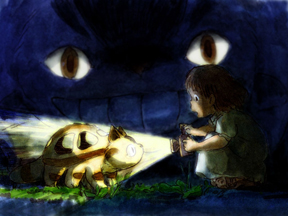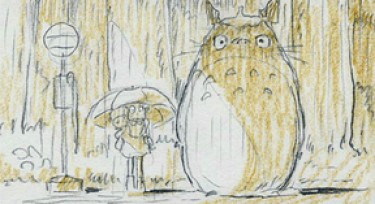Commentary &Miyazaki 20 Jan 2006 09:16 am
Totoro
Notes:
The difference between animating from pose to pose and animating straight ahead is an enormous one. They are what they sound like:
- In one you create poses, key drawings, and you put drawings inbetween the poses. Tex Avery was all about his poses, as was Bob Clampett. In animating this way, you plan out every motion and submotion. It’s all organized and ready for an inbetweener to complete. The animator is in absolute control.
- In animating straight ahead, an animator starts at the beginning and gets where (s)he has to – one drawing at a time. It’s hard to control the shape of the character: they start small and grow large or start with a bigger head than they end with. It’s hard to control the exact placement of the character, and it’s hard to figure out how to have an inbetweener help you. But, for some animators, with straight ahead animation the character lives and breathes on its own. A life form starts to exist, and a singular relationship can form between animator and animation. This process was part of the reason Ub Iwerks left Disney’s studio – he did not want to be forced to use an inbetweener.
Last night I watched My Neighbor Totoro for the umpteenth  time on Turner Classic Movies. The new voices were sterling. Dakota Fanning is alway beyond professional; she has nuances in her voice that can’t be taught by an acting coach. Elle Fanning, Dakota’s younger sister, was the surprise. She brought such joy to this little animated girl, everything Miyazaki could have hoped for in the animation was there , echoed in the voice. A brilliant choice and brilliant voice production by Rick Dempsey. The kids are an enormous part of this film.
time on Turner Classic Movies. The new voices were sterling. Dakota Fanning is alway beyond professional; she has nuances in her voice that can’t be taught by an acting coach. Elle Fanning, Dakota’s younger sister, was the surprise. She brought such joy to this little animated girl, everything Miyazaki could have hoped for in the animation was there , echoed in the voice. A brilliant choice and brilliant voice production by Rick Dempsey. The kids are an enormous part of this film.
In last week’s screening of Laputa, Castle In The Sky, John Lasseter suggested that Miyazaki does the storyboards completely, himself. In this way he can control the shaping of the film. He works in chronological order and builds his story. In fact, Lasseter told the story of Miyazaki getting lost at one point, in that he didn’t know where his storyboard was going to take him.
Putting this in animation terms, it’s the equivalent of animating straight ahead. He knows where he has started; I’m sure he has a pretty good idea of where he wants to go, but he’s letting the story take him there on its own.
 Suddenly, I realized all of Miyazaki’s works were composed of set-pieces. In the best of his films, like Totoro, these set-pieces are ingeniously controlled to build to an enormous whole, delicate and human. In Princess Mononoke, the set-pieces intertwine in a complicated web to create an epic vision of all of nature and human interaction with it.
Suddenly, I realized all of Miyazaki’s works were composed of set-pieces. In the best of his films, like Totoro, these set-pieces are ingeniously controlled to build to an enormous whole, delicate and human. In Princess Mononoke, the set-pieces intertwine in a complicated web to create an epic vision of all of nature and human interaction with it.
Now, I had a small insight into why and how they were structured this way.
This is not unlike Disney’s Bambi or Pinocchio. The adaptations of these two books forced this structure on the final films, but the enormous skill with which they were devised into final films is extraordinary. (Animators usually talk about the excellence of the visual aspects of these two films, but the story is just as wonderful.
In films I like less, such as Laputa, these set pieces – to me – feel episodic. There’s always the stunning visual imagery; the individual parts can be magnificent (such as the chase in this film with the railroad tracks and bridges collapsing behind the vehicles), but in the end it can get tiresome.
All of Miyazaki‘s films, however, have a singular vision – an auteur at the height of his craft. We know a lot about him, just by viewing his films. It is miraculous that one person (with an army behind him) could have done so many great works in animation and, at the same time, have had such success in the marketplace.
It’s a pleasure to have been given a small insight into his process and to see that it has such an enormous effect on the final film. Thank you John Lasseter for your introduction.

on 20 Jan 2006 at 2:48 pm 1.Jenny Lerew said …
Brilliant post. Thanks.
on 24 Jan 2006 at 3:42 am 2.Daniel Thomas said …
I one of the things I really enjoy about Miyazaki’s work is his narrative style, which reminds me greatly of serial cliffhangers. It’s episodic, but not especially in the way American movies or tv shows are episodic. The stories evolve, mutate, and grow in their own directions. There’s always an overall story arc, a beginning, middle, and end, but they’re far less linear than what’s expected in the West.
I think this is something that can cause confusion, especially with Howl’s Moving Castle, which seems deliberately designed to throw off viewers who expected a Harry Potter clone. It’s something that only became obvious to me the further I delved into Miyazaki and Isao Takahata’s work.
His narrative structure was largely shaped by television: Lupin III, Future Boy Conan, and the landmark World Masterpiece Theatre productions of Heidi, 3000 Leagues in Search of Mother, and Anne of Green Gables. The two Panda Kopanda shorts (which, aside from Takahata’s directing, is mostly his work) also fill out at around 35 minutes. It’s not surprising, considering that his first directoral film was Lupin III: Castle of Cagliostro in 1979, that the Miyazaki style had already solidified.
Conan, especially, is a signature Miyazaki anime, as it was purely his child, as well as his directoral debut. An adventure serial straight out of old Errol Flynn pictures, with generous doses of slapstick comedy, romanticism, action, and his own obsessions about human nature, civilization vs the natural world, yadda yadda, all wrapped up in 26 episodes. Hmm. It may be THE definitive Miyazaki, situated perfectly between Horus and his Nausicaa graphic novel, which to my mind remains his masterwork.
His Ghibli films become less obviously episodic as the years go by, but I think he just became more skilled at scrubbing away the stitches. The last time I watched My Neighbor Totoro was when I was making come copies for family members for Christmas (I have the Hong Kong DVD, haha), I was struck by its darker, more somber tone in the final act. The movie revolves around the older daughter’s growing awareness of her mother’s illness; her awareness of death. It’s not something Mei, the younger sister, can yet understand, and when she suddenly disappears, Satsuki’s inner fear of loss is made manifest.
This, of course, is Miyazaki’s personal filmmaking at work, and perhaps on one level the movie was his attempt to come to terms with his own mother’s serious illness, his own childhood. Is it any wonder that Totoro is at once so nostalgic and yet so idyllic?
I don’t think this awareness could have come about if a complete script was written at the very beginning; it had to come out during the act of creation. In the hands of most filmmakers, I don’t think this sort of thing could ever work, but to Miyazaki, it’s perfectly natural. It’s just how his creative process has always worked.
We see this process play out similarly in many of his films, and I think that’s why I like it more than the standard, American-style episodic structure. It doesn’t merely spin its wheels in perpetuity, playing out endless scenarios like television, but evolves, serves an overall point, and often finishes at a different place than you expected from the beginning. It’s either used dramatically (Castle in the Sky, Howl’s) or comedically (Porco Rosso).
I should also point out that Isao Takahata’s storytelling is similar, in films like Pom Poko and The Story of Yanagawa Waterways, his brilliant 1987 documentary. But I’m afraid I’m rambled on long enough. We’ll save that for next time.